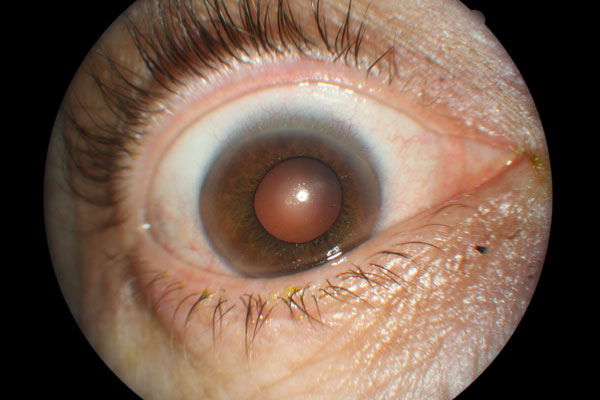Adult gonococcal keratoconjunctivitis: early detection is key
Abstract
We describe a case of a 52-year-old male presenting with severe mucopurulent conjunctivitis of the right eye. Corneal ulceration and associated anterior chamber activity was noted later in the course of the disease. Neisseria gonorrhoeae was positive on polymerase chain reaction (PCR) testing earlier than traditional microscopy and culture. He was successfully treated with ceftriaxone 500 mg intravenously and azithromycin 1 g orally as single doses in addition to ofloxacin ophthalmic solution 0.3% hourly to the right eye. This case highlights the need to consider the possibility of gonococcus in cases of suspected bacterial conjunctivitis, careful monitoring for corneal involvement and the importance of early detection with PCR.
References
Wan WL, Farkas GC, May WN, Robin JB. The clinical characteristics and course of adult gonococcal conjunctivitis. Am J Ophthalmol. 1986;102(5):575-583.
Ullman S, Roussel TJ, Culbertson WW, et al. Neisseria gonorrhoeae keratoconjunctivitis. Ophthalmology. 1987;94(5):525-531.
Duke-Elder S. Diseases of the outer eye. In: System of Ophthalmology Vol. 8. Part 1. St. Louis: CV Mosby Co; 1965:167-174.
Watt PJ. Pathogenic mechanisms of organisms virulent to the eye. Trans Ophthalmol Soc UK. 1986;105:26-31.
Lee JS, Choi HY, Lee JE, Lee SH, Oum BS. Gonococcal keratoconjunctivitis in adults. Eye. 2002;16(5):646-649.
Lahra M. Australian Gonococcal Surveillance Programme annual report, 2012. Commun Dis Intell Q Rep. 2013;37(3):E86-E87.
Australian Government Department of Health. National notifiable diseases surveillance system dataset. http://www9.health.gov.au/cda/source/cda-index.cfm. Accessed 2016.
McAnena L, Knowles SJ, Curry A, Cassidy L. Prevalence of gonococcal conjunctivitis in adults and neonates. Eye. 2015 Jul 1;29(7):875-880.
Coats DK, Carothers TS, Brady-McCreery K, Paysse EA. Ocular infectious diseases. In: Feigin RD, Demmler GJ, Cherry JD, Kaplan SL, (Eds). Textbook of Pediatric Infectious Diseases. 5th ed. New York: Saunders; 2004.
Weinstein P. The Australian bushfly (Musca vetustissima Walker) as a vector of Neisseria gonorrhoeae conjunctivitis. Med J Aust. 1991 Nov;155(10):717.
Matters R, Wong I, Mak D. An outbreak of non-sexually transmitted gonococcal conjunctivitis in Central Australia and the Kimberley region. Commun Dis Intell. 1998;22(4):52-56.
Kawashima M, Kawakita T, Den S, Tomita M, Shimazaki J. Surgical management of corneal perforation secondary to gonococcal keratoconjunctivitis. Eye. 2009;23(2):339-344.
Ng LK, Martin IE. The laboratory diagnosis of Neisseria gonorrhoeae. Can J Infect Dis Med Microbiol. 2005;16(1):15-25.
Azari AA, Barney NP. Conjunctivitis: a systematic review of diagnosis and treatment. JAMA. 2013;310(16):1721-1730.
American Academy of Ophthalmology. Cornea/External Disease Panel. Preferred Practice Pattern Guidelines: Conjunctivitis-Limited Revision. San Francisco, CA: American Academy of Ophthalmology; 2011.
McElnea E, Stapleton P, Khan S, Stokes J, Higgins G. Challenges in the management of Neisseria gonorrhoeae keratitis. Int Ophthalmol. 2015 Feb 1;35(1):135-140.
Papp JR, Schachter J, Gaydos CA, Van Der Pol B. Recommendations for the laboratory-based detection of Chlamydia trachomatis and Neisseria gonorrhoeae—2014. MMWR Recomm Rep. 2014;63(no RR-2):1-19.
Centres for Disease Control and Prevention (CDC) Update to CDC’s Sexually transmitted diseases treatment guidelines, 2010: oral cephalosporins no longer a recommended treatment for gonococcal infections. MMWR Morb Mortal Wkly Rep. 2012;61(31):590-594.
Gerstenblith AT, Rabinowitz MP. The Wills Eye Manual. 6th ed. Philadelphia: Lippincott Williams & Wilkins; 2012.

Copyright (c) 2020 Daniel Lai, Keith Ong

This work is licensed under a Creative Commons Attribution 4.0 International License.
Authors who publish with this journal agree to the following terms:
- Authors retain copyright and grant the journal right of first publication, with the work twelve (12) months after publication simultaneously licensed under a Creative Commons Attribution License that allows others to share the work with an acknowledgement of the work's authorship and initial publication in this journal.
- Authors are able to enter into separate, additional contractual arrangements for the non-exclusive distribution of the journal's published version of the work (e.g., post it to an institutional repository or publish it in a book), with an acknowledgement of its initial publication in this journal.
- Authors are permitted and encouraged to post their work online (e.g., in institutional repositories or on their website) prior to and during the submission process, as it can lead to productive exchanges, as well as earlier and greater citation of published work (See The Effect of Open Access).


